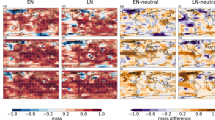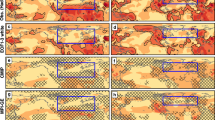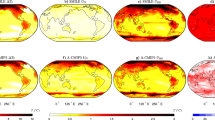Abstract
The slowdown in the rate of global warming in the early 2000s is not evident in the multi-model ensemble average of traditional climate change projection simulations1. However, a number of individual ensemble members from that set of models successfully simulate the early-2000s hiatus when naturally-occurring climate variability involving the Interdecadal Pacific Oscillation (IPO) coincided, by chance, with the observed negative phase of the IPO that contributed to the early-2000s hiatus. If the recent methodology of initialized decadal climate prediction could have been applied in the mid-1990s using the Coupled Model Intercomparison Project Phase 5 multi-models, both the negative phase of the IPO in the early 2000s as well as the hiatus could have been simulated, with the multi-model average performing better than most of the individual models. The loss of predictive skill for six initial years before the mid-1990s points to the need for consistent hindcast skill to establish reliability of an operational decadal climate prediction system.
This is a preview of subscription content, access via your institution
Access options
Subscribe to this journal
Receive 12 print issues and online access
$209.00 per year
only $17.42 per issue
Buy this article
- Purchase on Springer Link
- Instant access to full article PDF
Prices may be subject to local taxes which are calculated during checkout



Similar content being viewed by others
References
Kirtman, B. et al. in IPCC Climate Change 2013: The Physical Science Basis (eds Stocker, T. F. et al.) 953–1028 (Cambridge Univ. Press, 2013).
Meehl, G. A., Arblaster, J., Fasullo, J., Hu, A. & Trenberth, K. Model-based evidence of deep-ocean heat uptake during surface-temperature hiatus periods. Nature Clim. Change 1, 360–364 (2011).
Meehl, G. A., Hu, A., Arblaster, J. M., Fasullo, J. & Trenberth, K. E. Externally forced and internally generated decadal climate variability associated with the Interdecadal Pacific Oscillation. J. Clim. 26, 7298–7310 (2013).
Kosaka, Y. & Xie, S-P. Recent global-warming hiatus tied to equatorial Pacific surface cooling. Nature 501, 403–407 (2013).
England, M. H. et al. Slowdown of surface greenhouse warming due to recent Pacific trade wind acceleration. Nature Clim. Change 4, 222–227 (2014).
Easterling, D. R. & Wehner, M. F. Is the climate warming or cooling? Geophys. Res. Lett. 36, L08706 (2009).
Flato, G. et al. in IPCC Climate Change 2013: The Physical Science Basis (eds Stocker, T. F. et al.) 741–866 (Cambridge Univ. Press, 2013).
Santer, B. D. et al. Volcanic contribution to decadal changes in tropospheric temperature. Nature Geosci. 7, 185–189 (2014).
Schmidt, G. A., Shindell, D. T. & Tsigaridis, K. Reconciling warming trends. Nature Geosci. 7, 158–160 (2014).
Kaufmann, R. K., Kauppi, H., Mann, M. L. & Stock, J. H. Reconciling anthropogenic climate change with observed temperature 1998–2008. Proc. Natl Acad. Sci. USA 108, 11790–11793 (2011).
Showstack, R. White House climate action plan hotly debated in Senate hearing. Eos Trans. 95, 34–35 (2014).
Tollefson, J. The case of the missing heat. Nature 505, 276–278 (2014).
Watanabe, M. et al. Strengthening of ocean heat uptake efficiency associated with the recent climate hiatus. Geophys. Res. Lett. 40, 3175–3179 (2013).
Fyfe, J. C. & Gillett, N. P. Recent observed and simulated warming. Nature Clim. Change 4, 150–151 (2014).
Trenberth, K. E., Fasullo, J. T. & Balmaseda, M. A. Earth’s energy imbalance. J. Clim. 27, 3129–3144 (2014).
Loeb, N. G. et al. Observed changes in top-of-the-atmosphere radiation and upper-ocean heating consistent within uncertainty. Nature Geosci. 5, 110–113 (2012).
Meehl, G. A. et al. Decadal prediction: Can it be skillful? Bull. Am. Meteorol. Soc. 90, 1467–1485 (2009).
Meehl, G. A. et al. Decadal climate prediction: An update from the trenches. Bull. Am. Meteorol. Soc. 95, 243–267 (2014).
Balmaseda, M. A., Trenberth, K. E. & Kallen, E. Distinctive climate signals in reanalysis of global ocean heat content. Geophys. Res. Lett. 40, 1754–1759 (2013).
Guemas, V., Doblas-Reyes, F. J., Andreu-Burillo, I. & Asif, M. Retrospective prediction of the global warming slowdown in the past decade. Nature Clim. Change 3, 649–653 (2013).
Ding, H., Greatbatch, R. J., Latif, M., Park, W. & Gerdes, R. Hindcast of the 1976/77 and 1998/99 climate shifts in the Pacific. J. Clim. 26, 7650–7661 (2013).
Mochizuki, T. et al. Pacific decadal oscillation hindcasts relevant to near-term climate prediction. Proc. Natl Acad. Sci. USA 107, 1833–1837 (2010).
Smith, D. M. et al. Real-time multi-model decadal climate predictions. Clim. Dyn. 41, 2875–2888 (2012).
Meehl, G. A. & Teng, H. Case studies for initialized decadal hindcasts and predictions for the Pacific region. Geophys. Res. Lett. 39, L22705 (2012).
Meehl, G. A. & Teng, H. CMIP5 multi-model initialized decadal hindcasts for the mid-1970s shift and early-2000s hiatus and predictions for 2016–2035. Geophys. Res. Lett. 41, 1711–1716 (2014).
Taylor, K. E., Stouffer, R. J. & Meehl, G. A. An overview of CMIP5 and the experiment design. Bull. Am. Meteorol. Soc. 90, 1467–1485 (2012).
CLIVAR Data and Bias Correction for Decadal Climate Prediction 4 (CLIVAR Publication Series 150, International CLIVAR Project Office, 2011).
Corti, S., Weisheimer, A., Palmer, T. N., Doblas-Reyes, F. J. & Magnusson, L. Reliability of decadal predictions. Geophys. Res. Lett. 39, L21712 (2012).
Robson, J. I., Sutton, R. T. & Smith, D. M. Initialized decadal predictions of the rapid warming of the North Atlantic ocean in the mid 1990s. Geophys. Res. Lett. 39, L19713 (2012).
Yeager, S. et al. A decadal prediction case study: Late twentieth-century North Atlantic heat content. J. Clim. 25, 5173–5189 (2012).
Han, W. et al. Intensification of decadal and multi-decadal sea level variability in the western tropical Pacific during recent decades. Clim. Dyn. http://dx.doi.org/10.1007/s00382-013-1951-1 (2013).
Reichler, T. & Kim, J. How well do coupled models simulate today’s climate? Bull. Am. Meteorol. Soc. 89, 303–311 (2008).
Kim, H. M., Webster, P. J. & Curry, J. A. Evaluation of short-term climate change prediction in multimodel CMIP5 decadal hindcasts. Geophys. Res. Lett. 39, L10701 (2012).
Doblas-Reyes, F. J. et al. Initialized near-term regional climate change prediction. Nature Commun. 4, 1715 (2013).
Meehl, G. A. et al. Response of the NCAR Climate System Model to increased CO2 and the role of physical processes. J. Clim. 13, 1879–1898 (2000).
Acknowledgements
Portions of this study were supported by the Regional and Global Climate Modeling Program (RGCM) of the US Department of Energy’s Office of Biological & Environmental Research (BER) Cooperative Agreement # DE-FC02-97ER62402, and the National Science Foundation. We acknowledge the World Climate Research Programme’s Working Group on Coupled Modelling, which is responsible for CMIP, and we thank the climate modelling groups (listed in Table 1 of the Supplementary Information) for producing and making available their model output. For CMIP, the US Department of Energy’s Program for Climate Model Diagnosis and Intercomparison provides coordinating support and led development of software infrastructure in partnership with the Global Organization for Earth System Science Portals. The National Center for Atmospheric Research is sponsored by the National Science Foundation.
Author information
Authors and Affiliations
Contributions
G.A.M. conceived the study and wrote the initial draft of the paper. H.T. conducted and analysed the CMIP5 hindcasts. J.M.A. analysed the model and observational data. All authors contributed to interpreting the results, discussion of the associated dynamics and refinement of the paper.
Corresponding author
Ethics declarations
Competing interests
The authors declare no competing financial interests.
Supplementary information
Rights and permissions
About this article
Cite this article
Meehl, G., Teng, H. & Arblaster, J. Climate model simulations of the observed early-2000s hiatus of global warming. Nature Clim Change 4, 898–902 (2014). https://doi.org/10.1038/nclimate2357
Received:
Accepted:
Published:
Issue Date:
DOI: https://doi.org/10.1038/nclimate2357
This article is cited by
-
Critical stage temperatures in early spring modulate the growing season onset of Pinus tabuliformis in Shenyang
Trees (2024)
-
New insights into projected Arctic sea road: operational risks, economic values, and policy implications
Climatic Change (2023)
-
Effects of land-use change on carbon emission and its driving factors in Shaanxi Province from 2000 to 2020
Environmental Science and Pollution Research (2023)
-
Climate change in Brazil: evolutionary, comparative and forecast study
Theoretical and Applied Climatology (2023)
-
The Super-large Ensemble Experiments of CAS FGOALS-g3
Advances in Atmospheric Sciences (2022)



